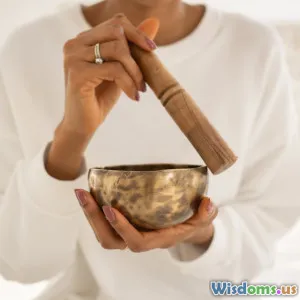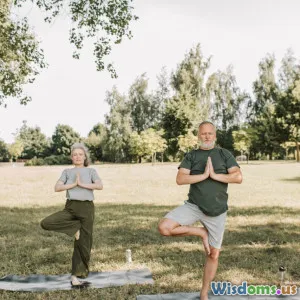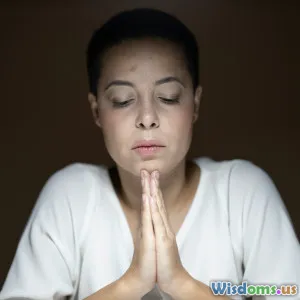
How Pranayama Breathing Practices Can Transform Your Daily Anxiety
7 min read Discover how pranayama breathing techniques can effectively reduce daily anxiety and promote mental well-being. (0 Reviews)
How Pranayama Breathing Practices Can Transform Your Daily Anxiety
Anxiety has woven itself into the fabric of our modern lives, covertly undermining mental peace and physical health. Whether triggered by work pressures, health concerns, or social dynamics, daily anxiety disrupts focus and dampens energy. But what if the remedy was as simple as the air you breathe? Pranayama — an ancient practice of controlled breathing rooted in yoga — offers a transformative approach to managing and alleviating daily anxiety.
Understanding Pranayama: More Than Just Breathing
Pranayama stems from the Sanskrit words “prana” (life force or vital energy) and “ayama” (extension or control). It is a technique that involves regulating the breath with intention and rhythm. Unlike casual breathing, pranayama focuses on breath control to harness and direct energy within the body and mind.
Scientific Insight into Breath and Anxiety
Anxiety often activates the sympathetic nervous system — the body’s fight-or-flight mode — leading to rapid, shallow breathing and increased heart rate. This response creates a feedback loop where anxiety intensifies physical symptoms, which in turn elevate anxiety.
Pranayama tricks this loop through conscious breath regulation, triggering the parasympathetic nervous system, sometimes called the “rest-and-digest” system. This shift reduces cortisol levels (the stress hormone), stabilizes heart rate, and promotes calm.
A pivotal 2017 study published in the International Journal of Yoga found that participants practicing alternate nostril breathing, a pranayama technique known as Nadi Shodhana, exhibited significant reductions in stress and improved autonomic nervous system balance.
Core Pranayama Techniques to Reduce Anxiety
1. Nadi Shodhana (Alternate Nostril Breathing)
Practiced widely for its grounding effects, this technique involves breathing alternately through each nostril, balancing the left and right hemispheres of the brain.
How to practice:
- Sit comfortably with a straight spine.
- Use your right thumb to close the right nostril and inhale slowly through the left nostril.
- Close the left nostril with your ring finger, release the right nostril, and exhale through the right.
- Inhale through the right nostril, then close it and exhale through the left.
- Repeat for 5-7 minutes.
2. Ujjayi (Victorious Breath)
Characterized by a soft constriction at the back of the throat, Ujjayi breathing creates a calming sound akin to ocean waves.
Benefits:
- Enhances oxygen intake.
- Regulates mind-body connection.
- Useful during stressful moments and meditation.
3. Sama Vritti (Equal Breathing)
In this technique, the inhale and exhale lengths are equal, helping to center the nervous system.
Practice tips:
- Breathe in quietly for a count of 4.
- Exhale for a count of 4.
- As you become more comfortable, extend counts progressively.
Real-Life Transformations and Practical Applications
Many individuals dealing with chronic anxiety report dramatic improvements by integrating pranayama into their routines. For example, Sarah, a marketing executive, shared her story of how 10 minutes of pranayama daily helped her manage panic attacks that once debilitated her work performance.
Healthcare settings have also adopted controlled breathing protocols. According to a 2018 survey in the Journal of Clinical Psychology, nearly 60% of patients who combined pranayama techniques with cognitive behavioral therapy (CBT) demonstrated enhanced treatment outcomes for generalized anxiety disorder (GAD).
Tips for Incorporating Pranayama Into Your Day
- Morning energizer: Begin your day with 5 minutes of Nadi Shodhana to set a calm and focused tone.
- Midday reset: Practice Sama Vritti during lunch breaks to alleviate accumulated stress.
- Pre-sleep ritual: Use Ujjayi breath to wind down before bedtime, promoting restful sleep.
Consistency is key. It might feel unusual initially but persisting for even two weeks can yield noticeable changes.
The Science Behind the Transformation
Research suggests pranayama influences blood chemistry by increasing oxygen saturation and reducing carbon dioxide, which enhances cognitive function and emotional regulation.
Importantly, a 2020 meta-analysis highlighted that breath regulation not only lowers anxiety symptoms but may also improve symptoms in depression and post-traumatic stress disorder (PTSD), further emphasizing the physiological influence of mindful breathing.
Conclusion: Breathing New Life into Anxiety Management
Daily anxiety can feel overwhelming, yet the solution is sometimes right under our nose — quite literally. Pranayama empowers individuals with a practical, research-supported tool to reclaim calmness and mental clarity. By weaving these intentional breathing practices into your daily routine, you tap into a profound resource capable of transforming your mental landscape and resilience.
Start small, breathe deeply, and watch as anxiety gradually loosens its grip, paving the way for a more serene and empowered life.
References:
- International Journal of Yoga, 2017: "Effects of alternate nostril breathing on autonomic functions in healthy individuals."
- Journal of Clinical Psychology, 2018: "Integrating breathing techniques with cognitive behavioral therapy for anxiety."
- 2020 Meta-analysis on breath regulation and mental health, Psychophysiology Today.
Rate the Post
User Reviews
Popular Posts





















